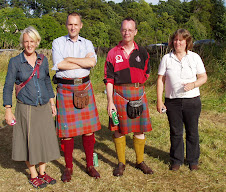We’re back. Readership scarcely declined during our absence. Why bother? I ask myself.
We were pretty lucky with the weather. A bit of snow, but none of the storms which afflicted England and indeed, I think, much of Europe. It’s funny, waking up in the country to snow. You thought you were alone, but the footprints reveal pheasants and deer and many rabbits and even, in our case, a human being, who came half-way down the driveway with a dog and then turned around.
 The driveway gave trouble yesterday – a first, for us, although our son-in-law Ed got stuck last winter. The snow wasn’t very deep, but rain had turned it to ice. The trouble started just around that corner. An industrious half hour chipping away, and spreading salt, did the trick – we didn’t have to enter the final stage of sacks and pushing. Just as well, at our age. With the previous driveway, life was like that all year round, mud being fully as impassable as snow.
The driveway gave trouble yesterday – a first, for us, although our son-in-law Ed got stuck last winter. The snow wasn’t very deep, but rain had turned it to ice. The trouble started just around that corner. An industrious half hour chipping away, and spreading salt, did the trick – we didn’t have to enter the final stage of sacks and pushing. Just as well, at our age. With the previous driveway, life was like that all year round, mud being fully as impassable as snow.
I have much to report on the knitting front, and comments from last time to answer. Today, however, will be devoted to etymology.
The new (February) Knitting was waiting for me here – I never did get around to cancelling it.
In it, Alice Starmore is quoted as saying: “Steek is a Scots word which means to ‘shut’ or ‘fasten’. In the context of needlework it means ‘a stitch’. When writing my Fair Isle book, I decided this was an appropriate word to use for the technique – a few Shetland women already did, and it is now used by knitters all over the world.”
OK, so far.
Starmore’s “Fair Isle Knitting Handbook” was first published in 1988, according to my copy.
Sarah Don’s “Fair Isle Knitting” appeared in 1979. She describes a variation of the technique of steeking, but doesn’t give it a name. I think it would be fair to say that her book was ground-breaking, in the sense that there hadn’t previously been a book in English devoted to the subject. But it is a slim vol., largely a book of patterns.
Sheila McGregor’s “The Complete Book of Traditional Fair Isle Knitting” appeared in 1981, seven years before Starmore. She uses the word “steek” in the now-familiar knitterly sense. Her book is what the title claims. It should be – and probably is – on every Fair Isle knitter’s shelf.
[I can’t find Feitelson this morning! Where is it? But I think she was published too recently to affect the discussion.]
The only possible conclusion is that Starmore had never seen McGregor’s book when she wrote hers. And it is, indeed, missing from her bibliography, although Don is present.
But I hope Starmore's version of events, as given in Knitting magazine, doesn’t now become accepted as gospel.
We were pretty lucky with the weather. A bit of snow, but none of the storms which afflicted England and indeed, I think, much of Europe. It’s funny, waking up in the country to snow. You thought you were alone, but the footprints reveal pheasants and deer and many rabbits and even, in our case, a human being, who came half-way down the driveway with a dog and then turned around.
 The driveway gave trouble yesterday – a first, for us, although our son-in-law Ed got stuck last winter. The snow wasn’t very deep, but rain had turned it to ice. The trouble started just around that corner. An industrious half hour chipping away, and spreading salt, did the trick – we didn’t have to enter the final stage of sacks and pushing. Just as well, at our age. With the previous driveway, life was like that all year round, mud being fully as impassable as snow.
The driveway gave trouble yesterday – a first, for us, although our son-in-law Ed got stuck last winter. The snow wasn’t very deep, but rain had turned it to ice. The trouble started just around that corner. An industrious half hour chipping away, and spreading salt, did the trick – we didn’t have to enter the final stage of sacks and pushing. Just as well, at our age. With the previous driveway, life was like that all year round, mud being fully as impassable as snow.I have much to report on the knitting front, and comments from last time to answer. Today, however, will be devoted to etymology.
The new (February) Knitting was waiting for me here – I never did get around to cancelling it.
In it, Alice Starmore is quoted as saying: “Steek is a Scots word which means to ‘shut’ or ‘fasten’. In the context of needlework it means ‘a stitch’. When writing my Fair Isle book, I decided this was an appropriate word to use for the technique – a few Shetland women already did, and it is now used by knitters all over the world.”
OK, so far.
Starmore’s “Fair Isle Knitting Handbook” was first published in 1988, according to my copy.
Sarah Don’s “Fair Isle Knitting” appeared in 1979. She describes a variation of the technique of steeking, but doesn’t give it a name. I think it would be fair to say that her book was ground-breaking, in the sense that there hadn’t previously been a book in English devoted to the subject. But it is a slim vol., largely a book of patterns.
Sheila McGregor’s “The Complete Book of Traditional Fair Isle Knitting” appeared in 1981, seven years before Starmore. She uses the word “steek” in the now-familiar knitterly sense. Her book is what the title claims. It should be – and probably is – on every Fair Isle knitter’s shelf.
[I can’t find Feitelson this morning! Where is it? But I think she was published too recently to affect the discussion.]
The only possible conclusion is that Starmore had never seen McGregor’s book when she wrote hers. And it is, indeed, missing from her bibliography, although Don is present.
But I hope Starmore's version of events, as given in Knitting magazine, doesn’t now become accepted as gospel.




And, speaking of "steeks". Schoolhouse Press have a DVD available in February showing the construction techniques of a Fair Isle Vest - including steeks and corrugated ribbing, subjects discussed here on your blog lately. Armed with the Starmore; Don and McGregor publications, it seems just the thing for creating a Fair Isle masterpiece, for those of us faint of heart. Jayne
ReplyDeletewww.schoolhousepress.com/videos.htm
Hi,Jean, I agree with you that it is an odd thing for Alice Starmore to have written, not least because if that's what the Shetland women called it,then she was just using the local name, as presumably were the other writers. However,I've been knitting for a fair few years, and always did my Fairisles on two needles. Sacha Kagan, for example, doesn't use steeks. I first saw the word in Starmore's "Celtic Knitting" and it put me off attempting any of the designs, because I didn't understand what she had in mind. So perhaps she did popularise the term.
ReplyDeleteYou're right, Feitelson was published in 1996.
ReplyDeleteHOWEVER.
"Knitting in the Old Way", the first edition, by Priscilla Gibson-Roberts has MASSIVE discussion of steeking and it appeared in 1985. It definitely, absolutely uses the word 'steek'. It's listed in the index.
"Knitting in the Nordic Tradition" by Vibke Lind discusses steeking and appeared in 1981 (excellent book, by the way, if you've never seen it). However, it was originally written in Norwegian and I won't swear one way or the other about whether the actual word 'steek' was used.
I wonder if Meg Swansen remembers when she first heard the word?
Alice is, as usual, full of it.
"Readership" numbers get a boost every time someone checks to see whether you've returned and posted again.
ReplyDeleteI agree with Julie... and by the way, Mary Thomas's knitting book described the technique in 1938, though without using the word "steek." She called it "peasant knitting" and I believe she connected it specifically with Scandinavia.
Well, as seems to be the usual case, AS has her own version of how it happened...as Julie said, she "is, as usual, full of it". But I do love her designs....
ReplyDeleteOf course your readership numbers stayed up, we were all checking everyday to see if you were back yet!
You do have to be well-armed to contradict SheWhoLovesToLitigateInScottishCourts. Julie is spot-on. AS is full of it and of herself. Nonetheless, her way with color is amazing. However, her ego is equally so.
ReplyDeleteI own all the aforementioned books--my very first Fair Isle effort was from Sarah Don's book--and I cannot imagine AS not having the McGregor book at the very least. Priscilla's book--well, it's not British, is it? So I wouldn't expect Alice to pay attention to it.
Funny this... i am foraying into designing my first color sweater - its based on EZ's Scandinavian sweater design in The Opinionated Knitter. But I am adding my own designs - its a fire truck based sweater - for a nephew who loves fire trucks. I am having such a blast - haven't been this happy in ages = and of course during the research went to both the DON (first) and then the McGregor - thank goodness I had bought them YEARS ago on ebay when I was first back to knitting - something said get these they will be useful for when .... as I have only just ventured into color knitting.
ReplyDeleteits a whole new world and i am enchanted.
I, for one would miss you Jean! And I was checking in every day to see if you'd posted anything new.
ReplyDeleteI remember reading of steeks early on in my knitting career (I don't believe I was married, so that would place it before 1984) in an issue of Threads magazine. IIRC, they referred to "steeks" specifically and described the technique of wrapping the yarn around the needle in one round and dropping the wraps in the next.